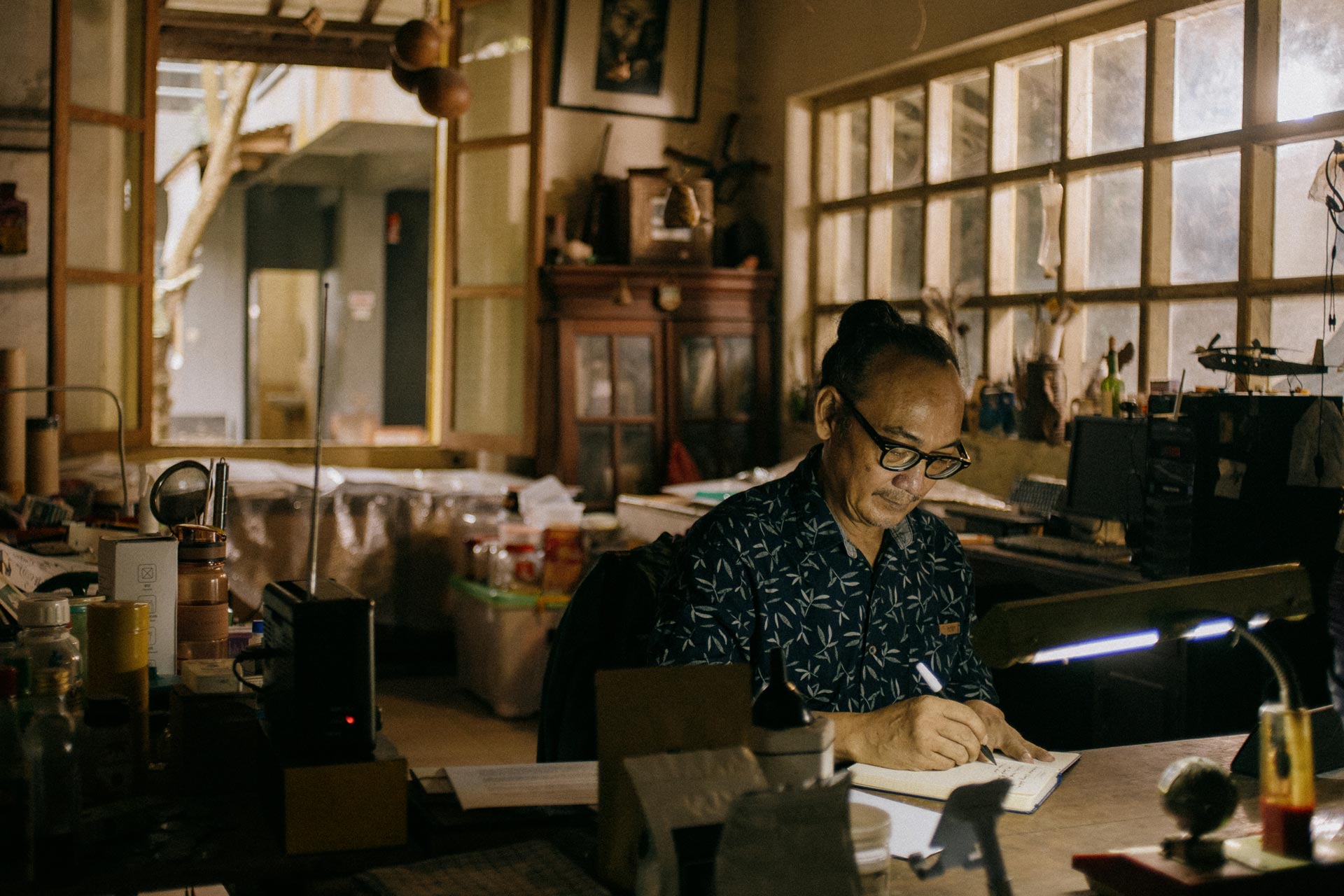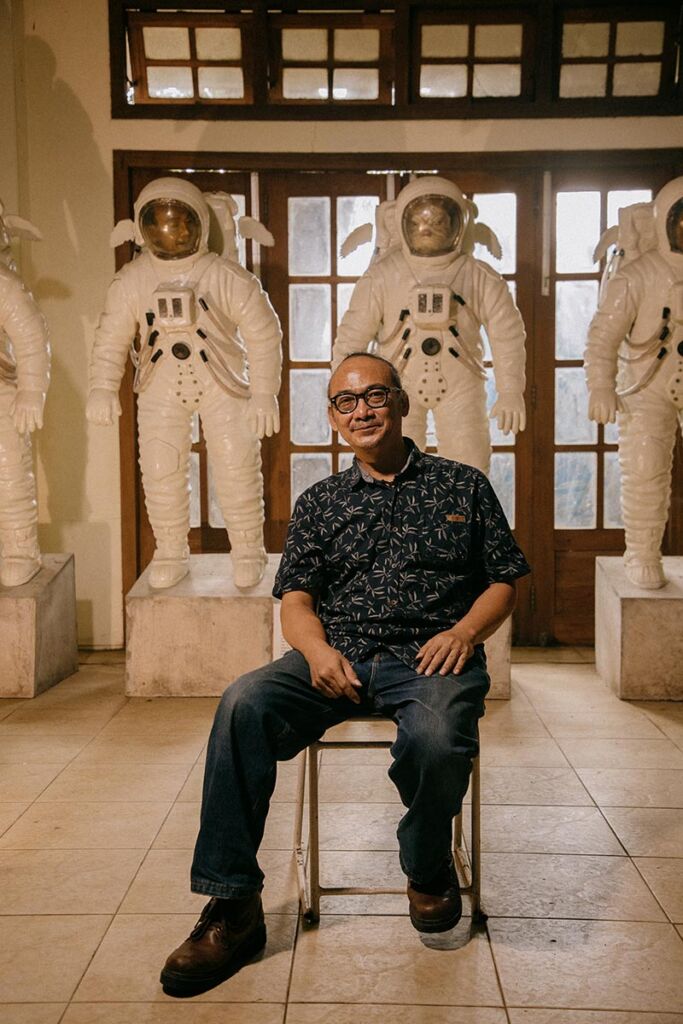Free Shiping All Around Indonesia
Free Shiping All Around Indonesia

There is a particular sense of serenity upon entering Heri Dono’s Studio Kalahan. Its serenity, however, is laced with a bit of eeriness because there are so many mannequins you could’ve easily mistaken as a person. Inside Studio Kalahan are three buildings worth of archives of Heri Dono’s artistic journey.
The artist himself welcomed us with cups of tea and loads of stories. Heri Dono (62) is the epitome of contemporary art. There is an unmistakable brilliance in the way he speaks, very much apparent through strings of references he casually cited during our conversation. Very much meticulous about his craft, shown through a detailed timetable of his schedule of the month, and folders of archives of his previous works, complete with the drafts and thought process.
His knack for experimenting, the artist would later reveal, has grown since his college days, when he opted not to finish the degree to pursue something newer. Walk around the studio and you’ll see the manifestation of a combo between art and technology, between the right brain and left brain. Surrounded by his installation, we talked about his artistic journey, his approach to art and technology, and his definition of contemporary art.

How and when did you first become interested in art?
HERI DONO: When I was a child, when my father worked for President Soekarno around 1967, he often took me along to the Bogor Presidential Palace, where President Soekarno was isolated after the G30S/PKI. As a part of Tjakrabirawa, my father still worked for the president when the new government had not been established yet. Even before that, many artists often left their paintings in my house to be sent to the Bogor Presidential Palace for President Soekarno’s collection. In my experience at the palace, I saw all those artists’ paintings.
Then, when I was in elementary school, whenever teachers asked about my life goals, I would tell them I wanted to be an artist. My friends often answered with pilots, doctors, and engineers, but I chose to be an artist. And my goal was to enroll in ASRI, even though I didn’t know what the school was like. When I was 17, I began painting and sculpting. Then in 1980, I enrolled at ASRI Art School in Jogja, majoring in Fine Arts, where I experimented with art. For example, art and its connection with sound, forces, and kinetics, like Alexander Calder. I was first interested in kinetics that is powered by wind, by natural resources. After that, I got interested in kinetics that is powered by electronics or mechanics.
In college, there was a subject called experimental art, where I once put an object on the ceiling fan blades to make it go around. I also brought in an aquarium and turned it into an aquarium art. I eventually did so many experiments until I met Sukasman, a shadow-puppet maker. In 1988, I orchestrated a Bataknese shadow-puppet show titled Si Tungkot Tunggal Panaluan at Seni Sono, which is now a part of Gedung Agung near the Post Office.
When did you start going abroad?
HERI DONO: In 1990 I started to go overseas. I lived for a year in Switzerland, where I stayed in an orphanage for about six months, then moved to an artist’s residence. There, I started to see paintings in museums and galleries. Switzerland is, in fact, the center of Art Basel. In the city of Basel, there is a place called Art Basel. Now, there is the annual Hong Kong Art Basel, Miami Art Basel, and so on. I started to see artworks in other countries too, Germany, Austria, France, the Netherlands, and so on.
I came back to Indonesia in 1991, and in 1992 I joined an exhibition called “New Art from Southeast Asia” in Japan, where I went around Hiroshima, Fukuoka, Osaka, and Tokyo. The following year, I joined the “Asia Pacific Triennial” in Australia, went to a residency program in England in 1995, then held a solo exhibition at MoMA, Oxford. The traveling never stopped until right before the pandemic. In March 2019, I went from Jakarta to Jogja and have never moved since due to the pandemic. For 2.5 years I only moved between Jogja and Jakarta.
Along the way, I keep experimenting with visual arts, installation arts, shadow-puppet arts, performing arts, video arts, and sound arts; exploring conventional arts and non-conventional arts.
How do these overseas trips and residencies affect you artistically?
HERI DONO: In the development of human psychology, there are ego, id, and alter ego or superego. In the ‘80s, I had this dream to go overseas. At that time, I imagined that if I wasn’t in Indonesia, I might get a clearer picture of Indonesia. If I stayed here, I would have difficulties differentiating between Indonesia and other countries. When I was working abroad, the issues that I wanted to convey became clearer. This was also due to a lot of information in Indonesia, particularly on the New Order era, being censored. When we talked about the 1965 coup d’état, we couldn’t speak of it here in Indonesia because the military coup d’état was considered nonexistent by the government. But, that information existed abroad. If we only refer to the issues here, where everything is censored, the newspaper and all, we wouldn’t be able to get inspired by the other truths, if we considered truth as a plural thing. When I was abroad, I could see, for example, the issue of discrimination in Australia, between the Native Australians and the Anglo-Saxons. Here in Indonesia, we’re inclined to believe that there’s no discrimination in the West when in reality, discrimination exists. After colonialism ended, they started talking about human rights, when in reality they might have done awful things to non-Europeans when the Terra nullius (nobody’s island) theory emerged.